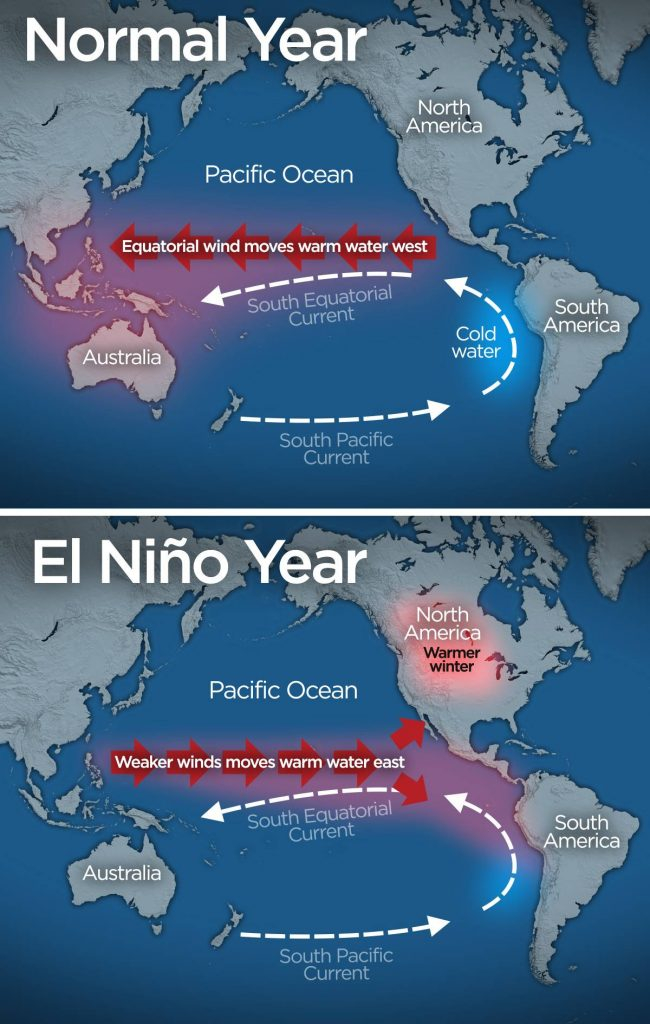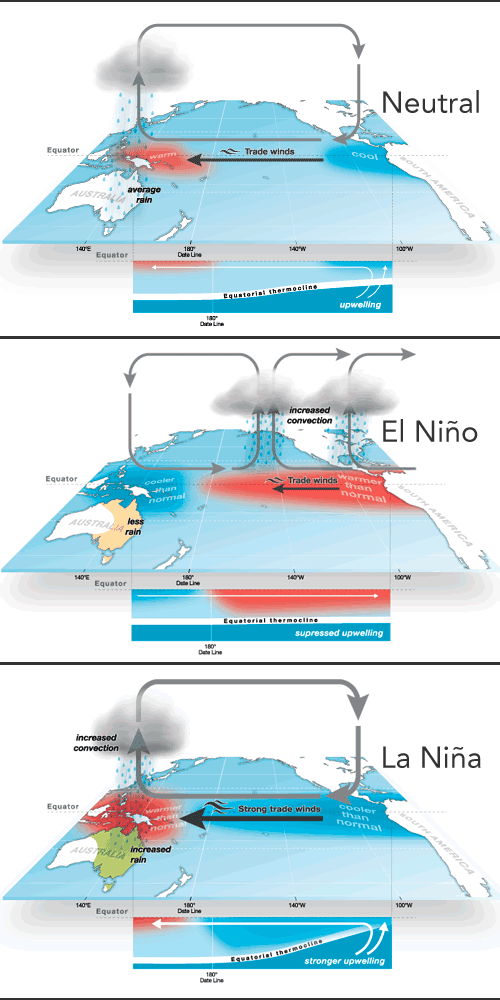Context:
This year the La Nina is being blamed for worsening the longest spell of heatwaves from March to April in north, west and Central India.
- In most years, meteorologists considered the La Nina to be a friend of India.
Relevance:
GS-I: Geography (Climatology, Important Geophysical Phenomena), GS-III: Environment and Ecology (Environmental Pollution and Degradation, Impact of Climate Change)
Dimensions of the article:
- La Niña
- El Niño
- Impact on India
- ENSO
La Niña
- La Niña is a coupled ocean-atmosphere phenomenon that is the colder counterpart of El Niño, as part of the broader El Niño–Southern Oscillation (ENSO) climate pattern.
- During a period of La Niña, the sea surface temperature across the equatorial Eastern Central Pacific Ocean will be lower than normal by 3 to 5 °C (5.4 to 9 °F).
- An appearance of La Niña persists for at least five months.
- It has extensive effects on the weather across the globe, particularly in North America, even affecting the Atlantic and Pacific hurricane seasons, in which more tropical cyclones occur in the Atlantic basin due to low wind shear and warmer sea surface temperatures, while reducing tropical cyclogenesis in the Pacific Ocean.
- La Niña is a complex weather pattern that occurs every few years, as a result of variations in ocean temperatures in the Equatorial Pacific.
- It occurs as strong winds blow warm water at the ocean’s surface from South America across the Pacific Ocean towards Indonesia.
- As this warm water moves west, cold water from the deep sea rises to the surface near South America.
- As a result, it is considered to be the cold phase of the broader El Niño–Southern Oscillation weather pattern, as well as the opposite of El Niño weather pattern.
- La Niña impacts the global climate and disrupts normal weather patterns, which as a result can lead to intense storms in some places and droughts in others.

El Niño
- El Niño is the warm phase of the El Niño–Southern Oscillation (ENSO) and is associated with a band of warm ocean water that develops in the central and east-central equatorial Pacific (between approximately the International Date Line and 120°W), including the area off the Pacific coast of South America.
- The ENSO is the cycle of warm and cold sea surface temperature (SST) of the tropical central and eastern Pacific Ocean.
- El Niño is accompanied by high air pressure in the western Pacific and low air pressure in the eastern Pacific.
- During the development of El Niño, rainfall develops between September–November.
- The cool phase of ENSO is La Niña, with SSTs in the eastern Pacific below average, and air pressure high in the eastern Pacific and low in the western Pacific.
- The ENSO cycle, including both El Niño and La Niña, causes global changes in temperature and rainfall.

Impact on India
- El Nino creates warm conditions over the Indian subcontinent in the winter and dry conditions and a lack of monsoon in the summer, whereas La Nina causes a better-than-normal monsoon in India.
- In an agricultural country like India, large departures from typical seasonal rainfall have a significant impact on agricultural output and hence the economy.
ENSO
- El Nino and the Southern Oscillation, also known as ENSO is a periodic fluctuation in sea surface temperature (El Niño) and the air pressure of the overlying atmosphere (Southern Oscillation) across the equatorial Pacific Ocean.
- El Nino and La Nina are complex weather patterns resulting from variations in ocean temperatures in the Equatorial Pacific Region. They are opposite phases of what is known as the ENSO cycle.
- El Nino and La Nina episodes typically last nine to 12 months, but some prolonged events may last for years.
-Source: The Hindu




